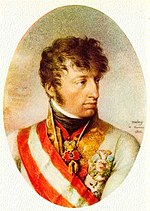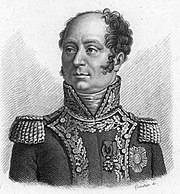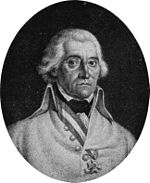Battle of Mannheim (1799)
Despite assistance by Michel Ney, Laroche's division was beaten and driven out of the city when attacked by Charles and a much superior force.
The War of the Second Coalition action occurred in the city of Mannheim, today located in the state of Baden-Württemberg in southwest Germany about 80 kilometres (50 mi) south of Frankfurt.
Provoked by this threat to his strategic rear, Charles and 30,000 troops moved north against Muller, who quickly withdrew.
Muller erred in leaving Laroche to be mauled by Charles, but his campaign became a strategic success when Masséna severely defeated a Russian army at the Second Battle of Zurich on 25 and 26 September.
[1] Though the French held their ground, Masséna evacuated Zürich the next day and withdrew to a strong position overlooking the city.
The army was responsible for an area along the Rhine River from Neuf-Brisach on the south to Düsseldorf on the north, including the fortresses of Breisach, Kehl, Strasbourg, Landau, Mannheim, Mainz, Ehrenbreitstein and Luxembourg.
In fact, much of the army's strength was tied up in garrisons and it is unlikely that the number of troops available for field operations exceeded 18,000.
This could be achieved by menacing Archduke Charles' supply line, which ran northeast from Switzerland to Ulm on the Danube River.
In the Battle of Novi on 15 August 1799, the Allies suffered 8,200 casualties, mostly Austrian, but chased the French army back into its last narrow slice of Italian territory near Genoa.
As soon as Korsakov's army was situated, Charles was to move north into southern Germany with 60,000 Austrians and invade France across the upper Rhine.
Tsar Paul I of Russia and Francis II, Holy Roman Emperor approved this plan and issued the necessary orders which arrived at Charles' headquarters on 7 August.
In fact, the archduke was reluctant to carry out the plan, since he believed that splitting up the Coalition armies was a mistake.
Success here would drive a wedge between Masséna's left wing and his center, compelling the French commander to withdraw from his position facing Zürich.
On the morning of 17 August, Charles massed 35,000 troops and battery of 40 cannons opposite his intended crossing place.
The Austrians were favored by good luck because Masséna was visiting his right wing that day and the defending 5th Division was under a temporary commander, Étienne Heudelet de Bierre.
The Austrian engineers blundered by selecting a poor site for their bridge and there was no covering force to protect the crews from French snipers.
[9] At the end of August 1799, Army of the Rhine was organized into three infantry divisions under Colaud, Antoine Laroche-Dubouscat and Jean François Leval and a cavalry reserve led by Jean-Joseph Ange d'Hautpoul.
It was rumored that the review was a cover for Muller's chief of staff Louis Baraguey d'Hilliers to carry out on a raid to Frankfurt in order to mulct the city for funds.
The French were also opposed by an Austrian force led by Anton Sztáray[10] which was supplemented by a local militia that its commander Count Albini styled the "German National Guard".
[14] At Mannheim, the French sustained losses of 1,600 killed and wounded, while their enemies captured 1,900 soldiers, 23 artillery pieces, 20 vehicles and two colors.
Soult's force sustained 1,100 casualties while capturing 3,500 Austrians and allied Swiss, 20 guns, 33 munition wagons, two colors and many supplies.
When news arrived of Hotze's defeat and death, Korsakov panicked and ordered a retreat to the north the next day.
[19] On 24 September Suvorov's column seized the Saint Gotthard Pass from Lecourbe's troops and entered Switzerland from the south.
[19] After a remarkable campaign in the Alps, followed by a harrowing march across Panix Pass in which some of the survivors were "spitting blood", Suvorov's Russian army escaped the French.
[21] Unhappy with Muller, the French government appointed Lecourbe the new commander of the Army of the Rhine on 25 September 1799.




